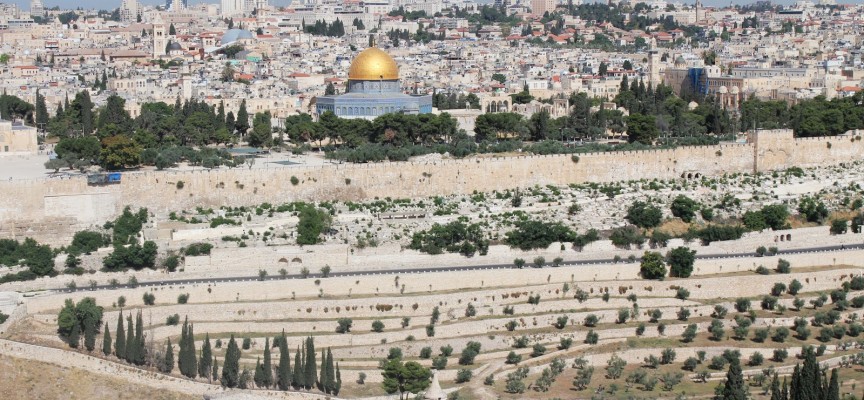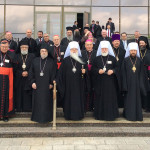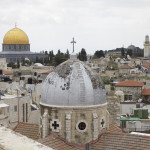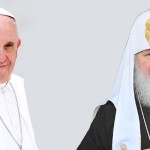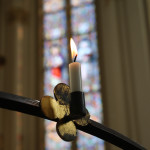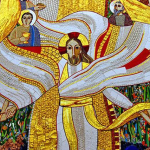Pope Francis goes on a pilgrimage to the Holy Land, the real reason being the common prayer with the Ecumenical Patriarch Bartholomew I, the highest representatives of orthodoxy. 50 years ago Pope Paul VI and Patriarch Athenagoras I met as brothers in the episcopate in Jerusalem, after centuries of separation between the Catholic and the Orthodox Church. It was an emotion which was felt all over the world. With the meeting in January 1964 doors were opened, which the events and changes in the church and in the world politics could close anymore.
What will the meeting between the Pope and the Ecumenical Patriarch at the place of the suffering and resurrection of Christ – the Holy Sepulcher, which in the language of the Eastern Church is more precisely called “Anastasis” (Church of the Resurrection) – bring this time? A decisive bold step forwards on the road to restoration of Christian unity? It would be no surprise by these two brave bishops of the Old and New Rome.
The Presidency of the Council of European Bishops’ Conferences (CCEE) made a call to the Catholics throughout Europe to accompany in prayer the three-day pilgrimage of the Pope and the Patriarch (24-26 May). Will this invitation of the bishops to the Catholics have a lasting effect? Too often, Christians in the Holy Land – Jesus’ homeland – feel abandoned by their brethren in Europe and generally in the West. Since the encounter between Paul VI and Athenagoras I 50 years ago millions of Christians have left in the Middle East. Also the Holy Land was and is still affected by the developments in this region. This shall not leave Christians in other parts of the world indifferent. For the “living stones” of the Christian community are more important than the structural evidence of the time of Jesus, the Apostles and early Christianity. It is true that in the State of Israel, the number of Christians remains unchanged, and there is even an increase through immigration of Christians from the Russian-speaking area and from countries where labor migration comes from (from Romania to the Philippines). But in other parts of the Holy Land the presence of Christians gets thinner and thinner.
In order to stop this development, an active solidarity with the Christians in the land of Jesus is required. This includes boosting the religious tourism as well as building concrete “bridges” through partnerships between dioceses, parishes, monasteries in Europe and dioceses, parishes, monasteries in the Holy Land (and other areas of the Middle East), but also promoting social and educational institutions, housing and employment opportunities for Christians. All these things have to be supported on the basis of prayer and sincere sympathy. The Church in the Holy Land shall not become a “museum”!
Papst Franziskus pilgert ins Heilige Land, der eigentliche Anlass ist das gemeinsame Gebet mit dem Ökumenischen Patriarchen Bartholomaios I., dem höchsten Repräsentanten der Orthodoxie. Vor 50 Jahren trafen in Jerusalem Papst Paul VI. und Patriarch Athenagoras I. nach Jahrhunderten der Trennung zwischen katholischer und orthodoxer Kirche als Brüder im Bischofsamt zusammen. Es war damals eine Weltsensation. Mit der Begegnung im Jänner 1964 wurden Türen geöffnet, die auch die Wechselfälle der Kirchen- und Weltpolitik nicht mehr verschließen konnten.
Was wird die Begegnung zwischen Papst und Ökumenischem Patriarchen am Ort des Leidens und der Auferstehung Christi – in der Grabeskirche, die im ostkirchlichen Sprachgebrauch richtiger „Anastasis” (Auferstehungskirche) genannt wird – diesmal bringen? Einen entscheidenden mutigen Schritt auf dem Weg zur Wiederherstellung der christlichen Einheit? Zuzutrauen wäre es den beiden mutigen Bischöfen des Alten und des Neuen Rom.
Das Präsidium des Rates der Europäischen Bischofskonferenzen (CCEE) hat an die Katholiken in ganz Europa appelliert, die dreitägige Pilgerreise von Papst und Patriarch (24. bis 26. Mai) im Gebet zu begleiten. Wird diese Einladung der Bischöfe an alle Katholiken eine Dauerwirkung haben? Allzu oft fühlen sich die Christen im Heiligen Land – in der Heimat Jesu – von ihren Glaubensgeschwistern in Europa und generell im Westen im Stich gelassen. Seit der Begegnung zwischen Paul VI. und Athenagoras I. vor 50 Jahren haben Millionen von Christen den Nahen Osten verlassen. Auch das Heilige Land war und ist weiterhin von dieser Entwicklung betroffen. Das darf die Christen in anderen Weltteilen nicht kalt lassen. Denn die „lebendigen Steine” der christlichen Gemeinden sind wichtiger als die baulichen Zeugnisse der Zeit Jesu, der Apostel und des Frühchristentums. Es stimmt, dass im Staat Israel die Zahl der Christen konstant bleibt, ja dass es sogar Zuwachs durch Immigration von Christen aus dem russischsprachigen Bereich und den Ursprungsländern der Arbeitsemigration(von Rumänien bis zu den Philippinen) gibt. Aber in anderen Teilen des Heiligen Landes dünnt die Präsenz der Christen aus.
Um diese Entwicklung zu stoppen, bedarf es einer aktiven Solidarität mit den Christen im Land Jesu. Dazu gehört die Ankurbelung des Pilgertourismus ebenso wie der konkrete „Brückenbau” durch Partnerschaften zwischen Diözesen, Pfarren, Klöstern in Europa und Diözesen, Pfarren, Klöstern im Heiligen Land (und anderen Gegenden des Nahen Ostens), aber auch die Förderung von Sozial- und Bildungseinrichtungen, Wohnraumbeschaffung und Arbeitsmöglichkeiten für die Christen – all dies getragen vom Fundament des Gebets und der aufrichtigen Sympathie. Damit die Kirche im Heiligen Land nicht zum „Museum” wird!
Due vescovi coraggiosi
Papa Francesco è in pellegrinaggio in Terra Santa; la vera ragione è la preghiera comune con il patriarca ecumenico Bartolomeo I, il più alto rappresentante dell’ortodossia. 50 anni fa si sono incontrati a Gerusalemme Papa Paolo VI e il Patriarca Atenagora I come fratelli nell’episcopato, dopo secoli di separazione tra la Chiesa cattolica e la Chiesa ortodossa. Fu allora un’emozione per tutto il mondo. Con l’incontro del gennaio 1964 sono state aperte delle porte, che le vicende alterne della politica ecclesiastica e mondiale non hanno più potuto chiudere.
Che cosa porterà questa volta l’incontro tra il Papa e il Patriarca ecumenico sul luogo della sofferenza e risurrezione del Cristo – il Santo Sepolcro, chiamato più correttamente nel linguaggio della Chiesa orientale “Anastasis” (chiesa della risurrezione)? Un passo coraggioso in avanti sulla strada del ripristino dell’unità dei cristiani? Ci sarebbe da attenderselo da quei due vescovi coraggiosi dell’Antica e della Nuova Roma.
La presidenza del Consiglio delle conferenze episcopali d’Europa (Ccee) ha lanciato un appello ai cattolici di tutta Europa per accompagnare la tre giorni di pellegrinaggio del Papa e del Patriarca (24-26 maggio) nella preghiera. Avrà un effetto duraturo quest’invito dei vescovi a tutti i cattolici? Troppo spesso i cristiani di Terra Santa – la patria di Gesù – si sentono abbandonati dai loro fratelli in Europa e in generale in Occidente. Dal tempo dell’incontro tra Paolo VI e Atenagora I, 50 anni fa, milioni di cristiani hanno lasciato il Medio Oriente. Anche la Terra Santa era ed è ancora interessata da quanto accade in questa regione. Questa situazione non deve lasciare indifferenti i cristiani in altre parti del mondo. Le “pietre vive “ delle comunità cristiane sono più importanti delle testimonianze architettoniche del tempo di Gesù, degli apostoli e della chiesa primitiva. È vero che nello Stato d’Israele il numero dei cristiani rimane costante, c’è addirittura un aumento grazie all’immigrazione di cristiani dell’area russofona e dei paesi di origine dei flussi migratori in cerca di lavoro (dalla Romania alle Filippine). Ma in altre parti della Terra Santa si assottiglia la presenza dei cristiani.
Per fermare questo sviluppo è necessaria una solidarietà attiva con i cristiani della terra di Gesù. Ciò include il rafforzamento del turismo religioso così come l’edificazione di ponti attraverso il gemellaggio tra diocesi, parrocchie, monasteri in Europa e diocesi, parrocchie, monasteri in Terra Santa (e in altre aree del Medio Oriente), ma anche la promozione d’istituzioni sociali ed educative, opportunità di casa e lavoro per i cristiani – tutto questo sostenuto dal fondamento della preghiera e della simpatia sincera. La Chiesa in Terra Santa non deve diventare un “museo”!
Erich Leitenberger
Spokesman "Pro Oriente" Foundation, Austria
Latest posts by Erich Leitenberger (see all)
- A special journey - 24 novembre 2014
- A day of deep mourning - 29 luglio 2014
- Some fresh air for Europe - 17 giugno 2014

